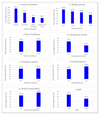Sociodemographic Determinants of Low Fruit and Vegetable Consumption Among Bangladeshi Adults: Results From WHO-STEPS Survey 2010
- PMID: 28434246
- PMCID: PMC6349139
- DOI: 10.1177/1010539517699059
Sociodemographic Determinants of Low Fruit and Vegetable Consumption Among Bangladeshi Adults: Results From WHO-STEPS Survey 2010
Abstract
This study aimed to investigate factors affecting fruit and vegetables (FAVs) intake among Bangladeshi adults. Dietary data of 9275 adults from the Bangladesh Noncommunicable Disease Risk Factor Survey 2010 were analyzed. The mean age of the respondents was 42.4 (±13.5) years. Multistage cluster sampling was applied to identify samples. Demographics, personal habits, physical activity, diet, and anthropometric data were collected using the WHO-STEPs questionnaire. Average daily intake of <5 servings of FAVs combined was considered to be low FAV consumption, and its prevalence was 82.8%. A mixed-effect logistic regression model was fitted to assess association of factors with low FAV intake. Higher educational attainment, greater wealth, female sex, low physical activity, body mass index >25 kg/m2, and smokeless tobacco consumption were significantly associated with higher FAV consumption. Frequency of low FAV intake increased with increasing age and decreased with increasing educational attainment. Programs targeting people at risk of low FAV consumption are needed to promote consumption.
Keywords: Bangladeshi population; NCD and risk factors; diet; fruit intake; vegetables intake.
Conflict of interest statement
The author(s) declared no potential conflicts of interest with respect to the research, authorship, and/or publication of this article.
Figures
Similar articles
-
The prevalence and social determinants of fruit and vegetable consumption among adults in Kenya: a cross-sectional national population-based survey, 2015.Pan Afr Med J. 2018 Oct 24;31:137. doi: 10.11604/pamj.2018.31.137.17039. eCollection 2018. Pan Afr Med J. 2018. PMID: 31037197 Free PMC article.
-
The Prevalence and Social Determinants of Fruit and Vegetable Consumption and Its Associations With Noncommunicable Diseases Risk Factors Among Adults in Laos.Asia Pac J Public Health. 2019 Mar;31(2):157-166. doi: 10.1177/1010539519830824. Epub 2019 Mar 10. Asia Pac J Public Health. 2019. PMID: 30854873
-
Fruit and vegetable consumption and its recommended intake associated with sociodemographic factors: Thailand National Health Examination Survey III.Public Health Nutr. 2009 Nov;12(11):2192-8. doi: 10.1017/S1368980009005837. Epub 2009 May 19. Public Health Nutr. 2009. PMID: 19454123
-
Baseline fruit and vegetable intake among adults in seven 5 a day study centers located in diverse geographic areas.J Am Diet Assoc. 1999 Oct;99(10):1241-8. doi: 10.1016/S0002-8223(99)00306-5. J Am Diet Assoc. 1999. PMID: 10524389 Clinical Trial.
-
Carotenoids as biomarkers of fruit and vegetable intake in men and women.Br J Nutr. 2016 Oct;116(7):1206-1215. doi: 10.1017/S0007114516003056. Epub 2016 Aug 30. Br J Nutr. 2016. PMID: 27572625
Cited by
-
Differences in the Prevalence of Fruit and Vegetable Consumption in Spanish Workers.Nutrients. 2020 Dec 16;12(12):3848. doi: 10.3390/nu12123848. Nutrients. 2020. PMID: 33339303 Free PMC article.
-
Geographical and sociodemographic disparities in fruit and vegetables consumption among adults in Burkina Faso: baseline results from the 2013 WHO STEPS survey.BMC Public Health. 2023 Nov 14;23(1):2245. doi: 10.1186/s12889-023-17118-0. BMC Public Health. 2023. PMID: 37964247 Free PMC article.
-
Evaluation of the sexual function of men in Kazakhstan during 2021-2022: A cross-sectional study.Health Sci Rep. 2023 Feb 28;6(3):e1142. doi: 10.1002/hsr2.1142. eCollection 2023 Mar. Health Sci Rep. 2023. PMID: 36865526 Free PMC article.
-
The prevalence and social determinants of fruit and vegetable consumption among adults in Kenya: a cross-sectional national population-based survey, 2015.Pan Afr Med J. 2018 Oct 24;31:137. doi: 10.11604/pamj.2018.31.137.17039. eCollection 2018. Pan Afr Med J. 2018. PMID: 31037197 Free PMC article.
-
Low Daily Intake of Fruits and Vegetables in Rural and Urban Bangladesh: Influence of Socioeconomic and Demographic Factors, Social Food Beliefs and Behavioural Practices.Nutrients. 2021 Aug 16;13(8):2808. doi: 10.3390/nu13082808. Nutrients. 2021. PMID: 34444968 Free PMC article.
References
-
- World Health Organization (WHO) Global Strategy on diet, physical activity and health: promoting fruit and vegetable consumption around the world. [Accessed June 12, 2016]; http://www.who.int/dietphysicalactivity/fruit/en/index2.html.
-
- Wu Y, Zhang D, Jiang X, Jiang W. Fruit and vegetable consumption and risk of type 2 diabetes mellitus: a dose-response meta-analysis of prospective cohort studies. Nutr Metab Cardiovasc Dis. 2015;25:140–147. - PubMed
MeSH terms
LinkOut - more resources
Full Text Sources
Other Literature Sources


